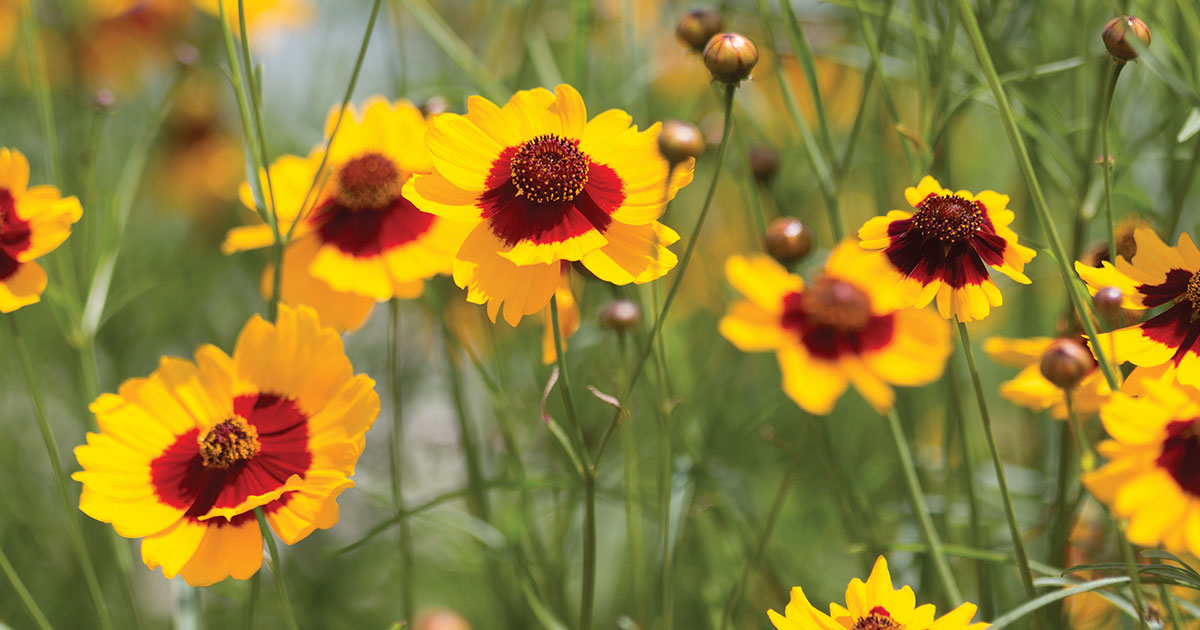After spending months reviewing seed catalogs, I find it a pleasure finally to see flats of potted flowers ready for planting and available for purchase. There is an immediate impulse to fill a cart with poppies, coneflowers, verbena and many other spring favorites; yet, we should heed one warning. In April and May, the last worry in a gardener’s mind is the effects of high humidity and stretches of time without precipitation. One solution is to consider planting one of the many drought-tolerant perennials!
Black-eyed-Susan: As a relative of the sunflower, the Black-eyed-Susan has yellow petals which spread out from a dark seed-core. Beneficial to insects, butterflies, birds, and bees, it stands tall, between 24 and 36 inches, and produces flowers all summer long. Once established, be aware, the Black-eyed-Susan can spread by either seed or division.
Blanket Flowers: Gaillardia is a slow-spreading garden flower which blankets an area through reseeding from mid-summer through fall. Similar to a daisy in appearance, the paintbrush colors are yellow at the tips and gradually change from orange to red at the center. A mature plant reaches up to 18 inches in height and can tolerate partial shade.
(Plant Stress Tip🙂 Ever wonder why you have newly potted flowers that die within a month? It’s important to check the health and growth of all new plants frequently. Consider inserting a stake in the ground, especially if you have a large garden. Take notice of the signs of stress, such as brown leaves or a lack of growth. Some plants may need immediate attention and care!
Coneflowers: Similar in appearance to an inverted daisy, coneflowers have petals that may be purple, white, or tangerine-orange in color, leading to a dark-seeded center. Growing up to four feet in height, the coneflower, also known as the medicinal herb, echinacea, enjoys full sun to part shade, attracts butterflies, and flowers all summer long.
Coreopsis: Also known as tickseed, the bright petals range in color from red, pink, and white, to yellow. While resembling a daisy, the distinct feature of the 33 species is its dark brown center. Care is easy. Only cut back the deadheads at midsummer to encourage the production of new flowers through the early fall. Check the label. Not all coreopsis are perennials.
(Planting Tip:) The phrase “well-drained” soil has little to do with placement. For instance, sloping soil most likely contains clay, which will result in a highly stressed plant. The goal of drainage is for the roots to stretch without sitting in water. Determine how to change sandy or clay-based soil by amending it with soil conditioner. Add a few handfuls of rock to the bottom of the hole; then, surround the plant with enriched soil. Don’t forget occasionally to add sources of minerals, such as a banana peel or crushed eggshell on the surface. Compostable items aid in enriching the soil and fostering health in all plants.
Lavender: Recognizable for its tall stems that end in a cluster of purple and fragrant flowers, lavender is a preferred plant for landscapes, walkways, and gardens. One alluring feature is “hardiness,” which means it will grow in a multitude of conditions; however, it thrives in warm temperatures, dry conditions, and well-drained soil.
Perennial Verbena: Verbena is a shrub; however, it also is a plant with small tubular flowers that grow in a cluster, reaching a maximum of one-foot tall. While purple and red are standard colors, unique hybrids appear in white, pink, and a striking magenta. It thrives in a location of great warmth and direct sunlight.
(Watering Tip🙂 Before planting, think about how you water. Is it through a hand-held hose, sprinkler, or slow-drip irrigation system? The means of watering will significantly affect where you choose to plant, and ensure all potted plants or seeds thrive in the best environmental conditions.
Wildflower Garden
Most drought-tolerant plants are ideal for a wildflower garden; therefore, consider adding companion perennials with similar soil conditions, such as poppies, Queen Anne’s Lace, Rosemary, sedums, and yarrow. This prime location should be away from the road and not frequented by people. Enjoy the wild space and allow nature to take over at least one area of the yard!






















